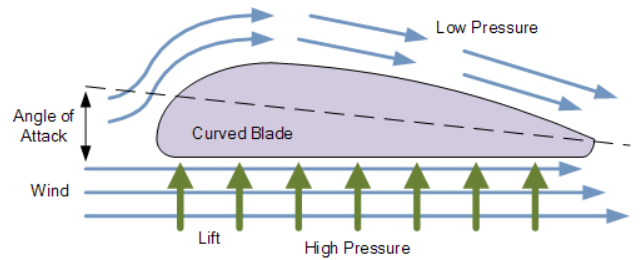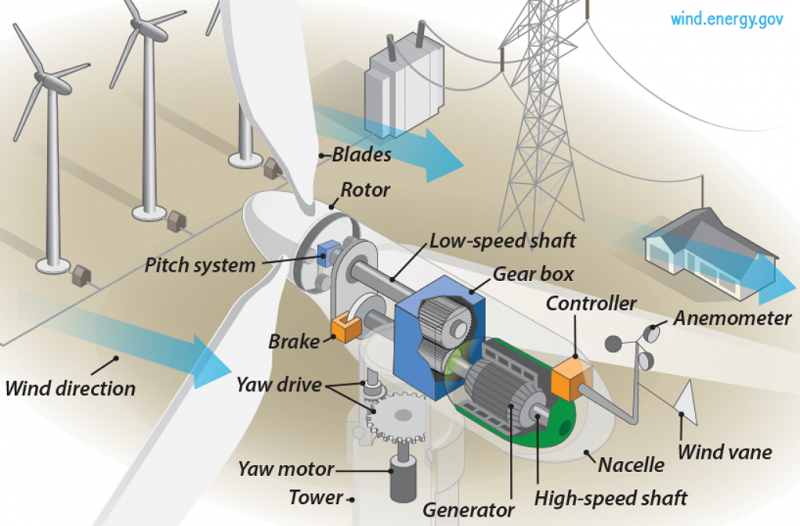Today, wind turbines commonly feature in our landscape. However, whilst we all may have seen one, not everyone understands how they work.
Wind
Wind turbines are designed to start operating at about 12-25 kilometres per hour – a gentle or moderate breeze. They are not designed to operate above 88kph – a strong gale, which could cause damage to the turbine.
Where wind meets the blade
As the wind blows towards the turbine, it encounters an obstruction – the turbine blade. Turbine blades have evolved from the flat, thick, wooden blades that we associate with windmills in Holland. They are now sleek and ergonomically engineered to achieve the best performance. The blades are heavily reliant upon the aerodynamics of the design, and wind tunnel testing allows designers to identify faults and improve upon blade designs.
Aerodynamics refers to the properties of a solid object, and how the air around it interacts with it. When wind interacts with a solid object, the velocity of the wind changes and the air moves around the object. Today, modern turbines have similar blade designs as the wings of an aeroplane.

Turbine blades are slightly curved on one side and flat on the other. The thicker part of the blade is where the wind first encounters the blade. From here it can either travel along the curved side of the blade, or the relatively flat side. The wind travelling along the curved side takes longer to reach the end of the blade than that which travels along the flat surface. This leads to low pressure accumulating at the curved side, ‘pulling’ the blade to the region of low pressure. This process is known as lift.
The blades of a turbine are twisted as they extend from the rotor to the blade tip. This increases the force exerted near the tip, as the tip moves much faster than at the rotor.

The nacelle
Inside the turbine head (known as the nacelle), there is a low speed shaft connected to the rotor. Large-scale turbines typically rotate at 20 rpm, while domestic sized turbines tend to revolve at roughly 400 rpm.
In most large-scale turbines, the low speed shaft is connected to a gearbox. The gearbox increases the rotational speed of the shaft, up to 1200-1800 rpm. This is the required rotational speed of most generators to produce acceptable levels of power.
The gearbox
The gearbox increases the rotational speed of one gear by connecting to a gear with a smaller radius. For instance, imagine the low speed shaft is attached to a gear with 20 teeth, which is connected to another gear with 10 teeth, which in turn is connected to the high-speed shaft. If the 20-toothed gear spins once, the gear with 10 teeth will have to turn twice. Therefore the high-speed shaft will be spinning at twice the speed of the low-speed shaft.
The generator
Inside the generator is where wind is converted to electrical energy. Here is how it works;
- The rotor rotates at the same speed as the blades and is connected to a low-speed shaft which rotates at the same speed.
- To increase the speed the shaft is rotating, the low-speed shaft is connected to a gearbox.
- The rotational speed of the low-speed shaft is increased substantially by the gearbox which is connected to the high-speed shaft.
- The high-speed shaft rotates much faster than the low-speed shaft.
- The high-speed shaft is attached to a coil of copper known as an armature inside the generator. The armature rotates at the same speed as the high-speed shaft.
- The armature is surrounded by a magnetic field, created by magnets within the generator. As the armature rotates through the magnetic field, a current is induced in the copper coil.
- The electricity generated in the copper coil is then extracted from the generator.

So we have come a long way from physicist Michael Faraday’s first electric generator in 1831! But lets not get into the details of electromagnetism in this blog…
Usable energy
The generator in wind turbines produces Alternating Current (AC) electricity. Some turbines convert this AC electricity to Direct Current (DC) with a rectifier, and then back to AC using an inverter. The purpose of this, is so the frequency and phase of the electricity is in line with that supplied by the grid.
By converting the variable speed AC current, produced by the generator, to DC current and then back to AC, the electrical signal is converted to a phase and frequency like that produced by the grid. Most electrical equipment in your home runs on predefined electrical conditions, and an unstable supply can damage your electrical equipment.
Maximising power
Turbines have a few nifty extra features that can maximise the amount of power generated. These include the ability to change pitch and yaw.
Pitch control – The pitch control system alters the angle of the blades. This allows the blades to find the best angle, to produce a safe steady rotation of the blades. The turbine’s electronic controller checks the power output of the turbine several times per second and if the power becomes too high, the pitch mechanism will pitch (turn) the blades slightly out of the wind. Conversely, if the power becomes too low, the pitch mechanism will pitch the blades back into the wind.
Yaw mechanism – The yaw mechanism turns the nacelle of the turbine, so that the rotor is perpendicular to the direction of the wind. In most large-scale turbines, data from a wind vane is processed by a control system, and the yaw mechanism will rotate the nacelle until the rotor is perpendicular to the wind. When the rotor is pointing in the opportune direction, the brake will engage and keep the nacelle pointing in that direction.
Where to go next
So what happens to all this generated electricity? Well, it can all be used on site, it can be sold back to the Distribution Network Operator (DNO) or it can be stored in batteries. All three options have benefits and the most appropriate one will depend on your circumstances, however a combination or all three can be implemented.
If you would like assistance with a wind turbine project, you can talk to us at Action Renewables, and we can provide you with some expert advice.


